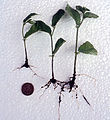Ulmus × hollandica 'Belgica'
| Ulmus × hollandica | |
|---|---|
 'Belgica', Amsterdam (2004) | |
| Hybrid parentage | U. glabra × U. minor |
| Cultivar | 'Belgica' |
| Origin | Belgium |
The hybrid elm cultivar Ulmus × hollandica 'Belgica' was reputedly raised in the nurseries of the Abbey of the Dunes (Abdij Ten Duinen), Veurne (later removed to Bruges), in 1694.[1] Popular throughout Belgium and the Netherlands in the 19th century both as an ornamental and as a shelter-belt tree,[2][3] it was the 'Hollandse iep' (:'Dutch elm') in these countries, as distinct from the tree known as 'Dutch Elm' in Great Britain and Ireland since the 17th century: Ulmus × hollandica 'Major'.[3] In Francophone Belgium it was known as orme gras de Malines.[2]
'Belgica' arose in the same hybridization zone that produced 'Ypreau' (possibly synonymous with 'Major'), 'Klemmer' and 'Dumont', among other elm cultivars.[4]
Description
'Belgica' has a broad crown supported by a straight, rough-barked stem. Unusually thriving on poor sandy soils, it proved one of the fastest-growing elms in Europe, typically achieving heights of < 40 m. The obovate to elliptic leaves are < 12 cm long by 5 cm wide, and terminate at the apex as a long, serrated point. 'Belgica' was prized, among other reasons, for its "ease and grace of twigs and foliage".[5]
-
Bole of 'Belgica'
-
'Belgica' leaves
Pests and diseases
Very susceptible to Dutch elm disease, it was the loss of this particular elm more than any other to the earlier strain of the disease which initiated the Dutch elm breeding programme in 1928.[6] 'Belgica' is also very vulnerable to verticillium wilt.[7]
Cultivation
'Belgica' was planted in great numbers along roads, streets and canals,[8] and also in squares, parks and gardens.[9] Its popularity and its aesthetic qualities are evidenced in photographic records of the Netherlands from the late 19th century to c.1920.[10][11] 'Belgica's "rapid growth even on poor soils and its good resistance to wind and atmospheric pollution"[12] made it an ideal choice for shelter-belt planting.
The cultivar has been introduced to arboreta in North America (see under Accessions), but there is no record of its introduction to Australasia.
-
'Belgica', Heerengracht, Amsterdam (1902)
-
'Belgica' avenue in the Netherlands (2007)
-
Rooted 'Belgica' cuttings
Notable trees
The Oudemanhuispoort 'Belgica' in Amsterdam, planted in 1895, is the largest elm in the Netherlands, with a height of 34.6 m and a girth of 4.4 m. [13] The UK TROBI champion tree grows at Dyke Park Road in Brighton, measuring 17 m high by 92 cm d.b.h. in 2009, one of nine trees forming part of the NCCPG Collection (see under Accessions).
A large tree identified as 'Belgian Elm' was photographed at the Ellwanger and Barry nursery at Mount Hope, Rochester, New York, circa 1900. Though the photograph is also captioned 'Superba', the tree, with its broad crown, more closely resembles 'Belgica'.
'Belgica' in art

The column-like boles, high-arching branches and graceful foliage of 'Belgica' elms ('Hollandse iepen') beside canals and streets in the Netherlands are celebrated in many of the paintings and drawings of the Dutch artist Karel Klinkenberg (1852–1924).[14]
Synonymy
- Ulmus batavina: Koch, Dendrologie; Bäume, Sträucher und Halbsträucher, welche in Mittel- und Nord- Europa im Freien kultivirt werden 2 (1): 414 1872.
- Ulmus belgica: Weston, The English flora 46. 1775.
- Ulmus campestris (: minor) bataviana: Simon-Louis, Metz, France, Catalogue, 1869.
- Ulmus montana (: glabra) var. belgica
- Ulmus × hollandica var. belgica
Hybrid cultivars
- 'Den Haag' (Ulmus pumila × Ulmus × hollandica 'Belgica'), raised in Holland in 1936.
Varieties
Augustine Henry considered the once widely-planted elm cultivar U. × hollandica 'Dumont' to be a variety of 'Belgica', calling it Ulmus belgica var. Dumontii.[15]
Accessions
- North America
- Arnold Arboretum. Acc. no. 322–81
- Longwood Gardens. Acc. no. 1967–0877
- Morton Arboretum. Acc. no. 1457–24
- Europe
- Brighton & Hove City Council, UK, NCCPG Elm Collection.[16] Examples planted at Dudeney Lodge, Dyke Road Park and Donald Hall Road
Nurseries
- Noordplant [7], Glimmen, The Netherlands.
References
- ^ Meulemans, M., and Parmentier, C., 'Studies on Ceratocystis ulmi in Belgium' in Research on Dutch Elm Disease in Europe (HMSO, London 1983)
- ^ a b c Elwes, Henry John; Henry, Augustine (1913). The Trees of Great Britain & Ireland. Vol. 7. pp. 1869–1871.
- ^ a b Richens, R. H., Elm, Cambridge 1983
- ^ Elwes & Henry, p.1870
- ^ Heybroek, H. M., (1982). 'Resistant Elms for Europe' in Research on Dutch Elm Disease in Europe, HMSO, London, 1983
- ^ Heybroek, H. M. (1993). The Dutch Elm Breeding Program. In Sticklen & Sherald (Eds.)(1993). Dutch Elm Disease Research, Chapter 3. Springer Verlag, New York, USA
- ^ Pegg, G. F. & Brady, B. L. (2002). Verticillium Wilts. CABI Publishing. ISBN 0-85199-529-2
- ^ Photographs of Ulmus x hollandica 'Belgica' in Amsterdam [1] [2] and rural Holland [3] [4]
- ^ Hilliers' Manual of Trees & Shrubs. (1977). David & Charles, Newton Abbot, UK
- ^ La Hollande illustrée, Librairie Larousse, Paris 1908
- ^ www.bontehoek.nl
- ^ Bean, W. J. (1988) Trees and shrubs hardy in Great Britain, 8th edition, Murray, London; p.647
- ^ The Oudemanhuispoort elm in Amsterdam (photographs 8 and 9) [5] ; photograph of columnar bole of the Oudemanhuispoort elm (to right of entrance) [6]
- ^ Johannes Christiaan Karel Klinkenberg
- ^ Henry & Elwes, p.1871
- ^ "List of plants in the {elm} collection". Brighton & Hove City Council. Retrieved 23 September 2016.




!['Belgica' near Rochefort, Belgium (1904), 9 feet (2.7 m) in girth at 48 years [2]: p.1871](http://upload.wikimedia.org/wikipedia/commons/thumb/9/96/Ulmus_x_hollandica_%27Beligica%27_on_road_from_Jemelle_to_Rochefort._48_years_old_and_9_feet_in_girth.jpg/75px-Ulmus_x_hollandica_%27Beligica%27_on_road_from_Jemelle_to_Rochefort._48_years_old_and_9_feet_in_girth.jpg)

